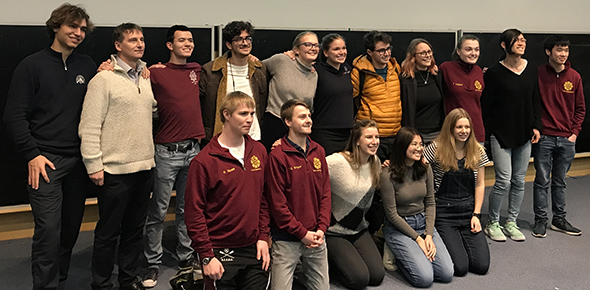Cambridge lecturer Dr Jenni Sidey-Gibbons returned to the Department of Engineering recently to host a special talk on her journey to becoming an astronaut with the Canadian Space Agency (CSA).
The first big lesson I learned was not to discount myself early on in the process. Have a lot more confidence in yourself, because you should never be the one to say no to yourself or turn yourself away from an opportunity.
Dr Jenni Sidey-Gibbons
This was the first opportunity Dr Sidey-Gibbons had had to visit colleagues and students at the Department since 2017, when she was recruited to the CSA as a member of the NASA astronaut class, alongside Gates Cambridge Scholar Kayla Barron.
As part of the Department’s ‘Inspirational Engineers’ talk series, Dr Sidey-Gibbons, Lecturer in Internal Combustion Engines, shared with students and staff her experience of the two-year astronaut training programme held at the Johnson Space Center, in Houston, Texas. She said the one-year astronaut recruitment process, prior to the training, was the greatest challenge she had faced to date and it had stretched her to her limits.
“I didn’t really know what I was getting myself into when I applied to the CSA to become an astronaut, and I certainly didn’t think that I would get the job, but I threw my name into the hat anyway and it started this year-long process of evaluation,” she said. “I had to juggle it with my first year of lecturing at Cambridge.”

Dr Sidey-Gibbons (centre) with students from St Catharine's College, where she is a Fellow alongside Professor Michael Sutcliffe (pictured second left).
“It was a really big year that involved me flying back to Canada for the assessment centres. They tested me on everything from physical fitness to problem solving and communication skills, but the big questions they wanted to answer were to do with if you can work under pressure effectively and whether you can work as a team.”
What followed was a two-year astronaut training programme which included scientific and technical briefings, intensive instruction in International Space Station (ISS) systems, simulated extravehicular activities (EVAs, or spacewalks), robotics, physiological training, flight training in a T-38 jet, Russian language courses, and sea and wilderness survival training.
“The first big lesson I learned was not to discount myself early on in the process. So what I’d say is whatever it is you want to do, just back yourself a little bit more than you think you should and have a lot more confidence in yourself, because you should never be the one to say no to yourself or turn yourself away from an opportunity.”
In response to a question from the audience on how best to pass the astronaut selection process, Dr Sidey-Gibbons said: “You have to be gritty and resilient. Lab experience also helps because of the operational skills you use. On the ISS, for example, you are, in some ways, a mechanic. Having outdoor expedition experience also helps, but I think the most important thing by far is getting along with people. If no one wants to go to space with you, you will not go to space!”
Last month, Dr Sidey-Gibbons officially graduated from the astronaut training programme. She will now begin a career in exploration that may take her to the ISS, on missions to the Moon under the Artemis program, or someday, Mars.

